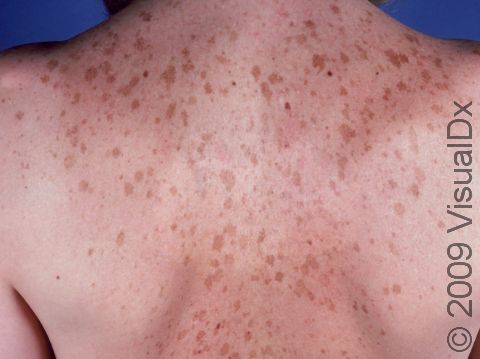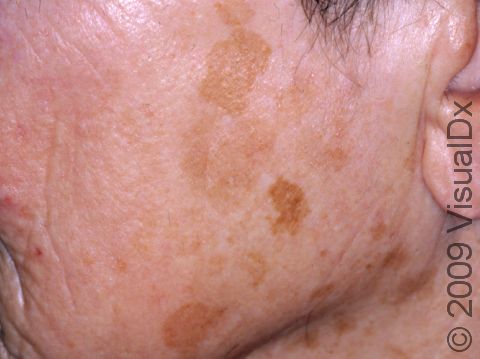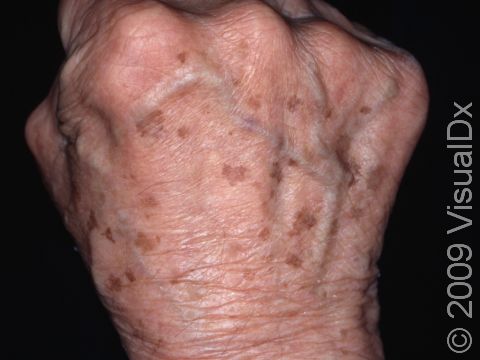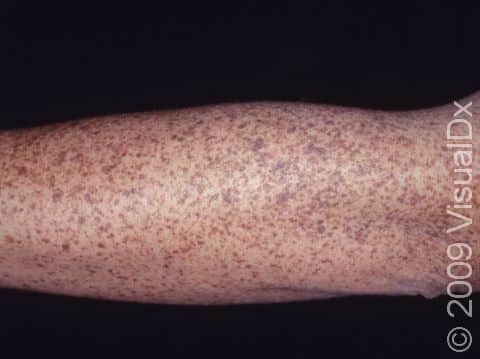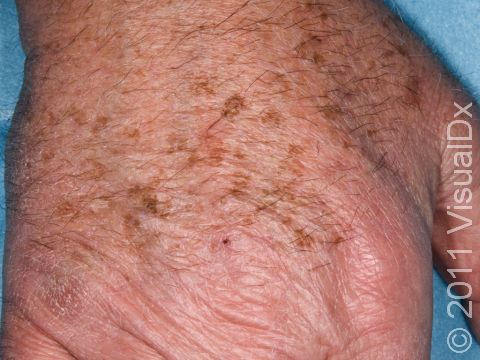Solar Lentigo
A solar lentigo (plural, solar lentigines), sometimes called an age spot or liver spot, is a brown macule (small, flat, smooth area of skin) caused by chronic sun or artificial ultraviolet (UV) light exposure. There may be just one lentigo or there may be multiple. This type of lentigo is different from lentigo simplex because it is caused by exposure to UV light. Solar lentigines are benign, but they do indicate excessive sun exposure, a risk factor for the development of skin cancer.
Who's At Risk?
Solar lentigines most commonly occur in older adults, particularly those who sunburn easily, but they can occur in children and young adults.
Signs & Symptoms
Solar lentigines appear as well-defined, light brown to black, flat macules, typically on areas exposed to sunlight. In people who have been treated with a form of UV light therapy called psoralen plus ultraviolet-A radiation (PUVA), solar lentigines may occur in areas of the skin not exposed to sunlight.
Self-Care Guidelines
To prevent solar lentigines, avoid exposure to sunlight during midday (10 AM to 3 PM), wear sun-protective clothing (tightly woven clothes and hats), and apply sunscreen with sun protection factor (SPF) 30 or higher that blocks UVA and UVB rays.
Treatments
Solar lentigines are noncancerous, so no treatment is needed. However, your medical professional may recommend periodic follow-up evaluation or surgical removal of a lesion that is difficult to distinguish from a malignant lesion, such as melanoma.
If solar lentigines are cosmetically bothersome, your medical professional may:
- Freeze the area lightly with liquid nitrogen (cryotherapy).
- Recommend laser therapy.
- Prescribe a bleaching cream (eg, hydroquinone) and/or a retinoid (eg, tretinoin).
Visit Urgency
Solar lentigines do not require medical care, but see a medical professional if you develop a pigmented lesion and you are not sure what it is or if you have an existing solar lentigo that changes in appearance, such as it gets larger or darker.
Trusted Links
References
Bolognia J, Schaffer JV, Cerroni L. Dermatology. 4th ed. Philadelphia, PA: Elsevier; 2018.
James WD, Elston D, Treat JR, Rosenbach MA. Andrew’s Diseases of the Skin. 13th ed. Philadelphia, PA: Elsevier; 2019.
Kang S, Amagai M, Bruckner AL, et al. Fitzpatrick’s Dermatology. 9th ed. New York, NY: McGraw-Hill Education; 2019.
Last modified on September 22nd, 2023 at 11:50 am

Not sure what to look for?
Try our new Rash and Skin Condition Finder
